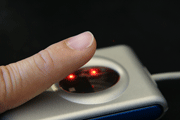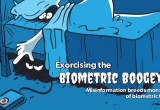Biometrics gets its ‘fingers’ into school foodservice
27 February, 2007
category: Biometrics, Education, Library
 By Ryan Kline, Contributing Editor
By Ryan Kline, Contributing Editor
The use of biometrics for identification and authentication is taking hold throughout the country and in our schools.
Way back in 1972, far before many people were even thinking of using biometrics in conjunction with daily authentication, the University of Georgia began using biometrics in their dining halls. The campus had decided to simplify their mealplan offerings—from a ticket-based program to an enrollment program—and they needed a way to accurately identify paid customers The same goal of simplification remains a core motivator when colleges, universities, and K-12 schools decide to use biometrics in their facilities.
Biometric identification is not a new concept. “The ancient Egyptians used bodily characteristics to identify workers to make sure they didn’t claim more provisions than they were entitled—just like governments today are looking at biometrics to lessen benefit fraud,” says Jay Fry, CEO of biometric developer, identiMetrics. And just like the University of Georgia has been doing for years.
Lower costs and increased accuracy has many school administrators looking to biometric as means of authenticating students. According to Mr. Fry, “price is no longer an obstacle…. Today, biometrics can actually be priced competitively with barcode readers, swipecard (magnetic stripe) readers and PIN pads.”
Though the number of schools utilizing biometrics is not known, Mitch Johns, CEO/President, Food Service Solutions, reports that his company has 65 school districts using their solution.
Bud Yanak, VP Marketing, BIO-key International, stresses that the advantages of biometrics far exceed those of other authentication techniques.
CR80News spoke with the three men in an effort to determine the state of biometrics in college and university as well as K-12 settings. Both are convinced that biometrics hold the key to solving the challenges of authentication in campus environments.
An interview with Charles Yanak, VP Marketing, BIO-key
What advantages do you think there are with a biometric system?
First, convenience … With biometrics, there is no need to remember a password or carry an ID card. You simply place your finger on a biometric reader that takes a picture of your finger, digitizes it and then compares it against a database of templates. For students, this is a major plus, since it eliminates the need to constantly be replacing lost or stolen IDs and it eliminates the possibility of sharing ID cards.
Second, security … Biometrics are far superior to current passwords/PINs and ID cards identification techniques for establishing identity. It’s very easy to “share” a password or PIN with someone and worse yet, they are easily forgotten or unknowingly obtained by someone looking to access your personal records or assume your identity. In the campus environment, biometrics can help eliminate:
- “Buddy punching”,
- students logging into systems using a teacher or administrator username and password to access protected information, and
- identity theft.
Is this a cost effective strategy to implement in schools?
Definitely … The cost to deploy biometrics has gone down significantly over the past 2 years. Three years ago, the average cost of a fingerprint reader was over $100. Now, they are included in most new laptop computers. External USB readers cost less than $40 today, one-third the price they were two years ago.
The cost to deploy a fingerprint biometric system is far lower than the costs to issue and manage ID cards and passwords. And they provide far better security since you can’t “borrow” or loose a finger like you can an ID card or password/PIN.
Why do you think so many people are afraid of using such secure technology?
Great question. There is still a lot of misinformation about biometrics and “Big Brother” concerns. The reality is we all use biometrics every day. Biometrics are defined as the ability to recognize someone by their physical attributes. You intuitively use biometrics when you pick up the phone and recognize the voice at the other end, or when you meet a friend on the street and recognize their face. However, people are concerned about how biometrics can be misused with “Big Brother” being able to track your every move. Banks, retailers and other institutions store and track a lot of information about us every day. Biometrics can protect access to this information! With biometrics deployed to access this information, our lives would be safer, since they would reduce or eliminate unlawful acts such as identify theft. Biometrics provide better security and confirm who has access to critical information and can improve your privacy since it can virtually eliminate or substantially reduce unlawful/unwanted access to your private information.
What sort of stereotypes can biometrics eliminate in the lunchroom?
Another great question. When two students are traveling down the lunch line side-by-side, they look identical to the system. When they get to the cashier, they both place their fingers on the reader to establish their identity and the system electronically debits their account. One of these students may in fact be buying his lunch with government aid. (With biometrics, there is no) negative stigma among peers. Another example … very young students often forget or lose their ID. With biometrics, the lunch line flows faster and eliminates the embarrassment when the student discovers he has forgotten or lost his ID or password.
An interview with Mitch Johns, CEO, Food Service Solutions
Have parents expressed apprehension to using biometrics with children?
The association with fingerprint-based biometrics is generally associated with law enforcement. AFIS systems store actual fingerprints while commercial applications only store a numerical template of the enrollment scan. Post 9-11 events including the Patriot Act and war on terrorism have elevated concerns over the Americans the loss of privacy. Using Opt In or Opt Out at time of implementation gives parents a choice.
What do you think the future holds for identification at schools around the nation?
More and more schools are considering doing away with ID cards and using biometrics in the lunch process. Schools are currently testing/using biometrics and GPS for tracking bus attendance. As security becomes an even bigger issue for schools biometrics will be used for door entry and attendance.
An interview with Jay Fry, CEO, identiMetrics
What about privacy issues?
Biometric technologies don’t conjure up the Orwellian fears they used to. Of course, some people still grumble at the mention of systems that scan fingerprints because of misunderstood privacy fears, but overall the acceptance of biometrics has risen substantially over the past few years. In fact, people are now realizing that biometrics actually protect their privacy and that in many biometric applications, including the one identiMetrics employs, their fingerprints are not stored anywhere and their fingerprints can never be recreated from the digital template. Minutiae based systems, like ours, use flat images to create templates. Flat images reveal the center of the finger and require only a minimum of unique identifying points in order to make a match. The purpose is to identify a person already enrolled in the software. Fingerprints can never be recreated.
Why would a school use biometrics?
Quite simply, to save time and money, and improve the accuracy of reporting. Biometric technology can provide benefits in terms of convenience, safety and security. There are two areas of identification that schools have to manage: students and employees. Biometrics are beginning to be used in both of these areas.
In some schools, teachers, staff and employees (use biometrics) for time & attendance, making record keeping very accurate. It can be used to identify people that come into the school on a regular basis, like substitute teachers, contractors, parents, so you know who is in your school and when they left.
Biometrics can be used to identify students as well. The cafeteria is usually the first area in the school to embrace biometrics. With up to 80% of students forgetting or losing their cards on a daily basis or forgetting or sharing their PINs, lines are slowed and mistakes are made. Biometrics will be used:
- in vending machines to ensure positive identification of children eating free or reduced lunch
- for attendance to eliminate “buddy punching” and provide irrefutable proof of attendance and help cut down on “class cutting” when attendance is taken on a period-by-period basis
- in the library to checkout books
- in the nurse’s office to make sure that the students are receiving the correct medication.
How do you begin to implement biometrics on campus?
Start by making small improvements. You want to improve productivity, record keeping and of, course, safety. Take baby steps! Identify and assess your “pain.” Where in your school could the use of finger scanning instead of cards and PINs save you time and money? We have found that in most schools it’s in the cafeteria.
Why the cafeteria?
About 65% of purchasing that is not facilities-related in schools is done by food service departments. Food service is a business and it needs to run efficiently.
There’s a growing interest in the use of biometrics for student ID in school cafeterias nationwide. By just about every measure, finger scanning biometrics outpace other options for efficiency and ease. When a child presses a finger into a scanner, there’s no doubt about his or her identity. There’s no risk of lost ID cards or forgotten PIN numbers. There’s no chance of fraudulent use of the child’s meal account by someone else. Biometric ID also provides anonymity and eliminates any stigma for the children who receive free or reduced-price lunches, (therefore increasing) participation in the National School Lunch Program. And increased participation – can translate into more funding for districts.
Another key area of focus is healthier vending. Instead of going to the cafeteria, a student can purchase a prepaid, reimbursable meal from a vending machine. The machines being tested are tied into a point-of-sale system, and they can track the purchases to prevent a student from buying two lunches on the same day. And biometric finger scanning will ensure accurate record keeping – a must for federal and state reimbursement.
What should a school think about when choosing the right biometric solution?
- Choose a biometric identification platform that can eventually be used throughout your entire school. This means that students should be enrolled only once to be identified in a variety of areas in the school – the cafeteria, the front door or classroom for attendance, the nurse’s office, the library and the office for absence information entry. It’s just impractical to expect a Principal to disrupt the entire school to enroll the entire student body for each application that requires student identification.
- Make sure that it can scale if needed. Some biometric technologies work great with ten students or less in a standalone environment, but fail miserably as the number of students increase in a networked environment. A more robust biometric technology might cost a bit more, but will be worth it in the long run.
- Make sure that it can integrate with your software applications that you already have in place, if you don’t want to replace them.
Ask about performance accuracy. There are basically four metrics: false acceptance, false rejection, failure to enroll and failure to acquire rates. False acceptance rates are what you should be most concerned about. That means I place my finger on the scanner and your name comes up. - Compare, but not just on price. Check up on customer support and rollout experience. Once again, make sure the technology works in a practical school setting and not just in a vendor lab.
- Communication, communication and communication! Make sure everyone – parents, teachers, students, administrators, the school board and the media have up to date and accurate information about biometrics. identiMetrics has a “Guide to Implementing Biometrics” that includes, for instance, sample letters to parents, biometric FAQs, best practices and other important information to make the whole process run smoothly and easily.
Any concluding thoughts for institutions considering biometrics?
Cost-effective biometric technology is here today with practical uses for schools. It’s a perfect solution for schools who are dissatisfied with the current student identification systems in place such as PINs and swipecards. Biometrics, and in particular finger scanning systems, provide irrefutable proof of identification. Unlike the complicated and expensive government systems in the past, biometric finger scanning systems can be simple, cost-effective and technology friendly. If children can do it, you can, too. It’s just smart business!




